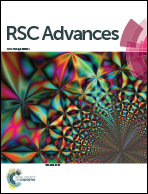Synthesis of micro–mesoporous ZSM-5 zeolite with microcrystalline cellulose as co-template and catalytic cracking of polyolefin plastics
Abstract
Micro–mesoporous ZSM-5 with different Si/Al ratios (MZ-X, X = 27, 80, 150) were synthesized by adding microcrystalline cellulose (MCC) as co-template into the hydrothermal synthesis process of zeolites. The resultant ZSM-5 were used for catalytic cracking of high density polyethylene (HPDE) and polypropylene. It was found that introduction of MCC significantly enhanced the formation of mesopores and strong acid sites. MZ-27 achieved the highest oil yield: 21.5% for HPDE and 32.1% for polypropylene, and the light aromatics (BTEX) selectivity therein were 87.6% and 79.7%, respectively. HZ-150 (MCC-free ZSM-5, Si/Al = 150) achieved the highest gas yield: 85.4% for HDPE and 76.7% for polypropylene, and the light olefins (C![[double bond, length as m-dash]](https://www.rsc.org/images/entities/char_e001.gif) 2–4) selectivity therein were 44% and 48.3%, respectively. The dense acidic sites and mesoporous structure of MZ-27 were responsible for its better activity for producing aromatic products. The moderate acidity and microporous structure of HZ-150 were helpful for producing light olefins from catalytic cracking of polyolefin plastics.
2–4) selectivity therein were 44% and 48.3%, respectively. The dense acidic sites and mesoporous structure of MZ-27 were responsible for its better activity for producing aromatic products. The moderate acidity and microporous structure of HZ-150 were helpful for producing light olefins from catalytic cracking of polyolefin plastics.



 Please wait while we load your content...
Please wait while we load your content...